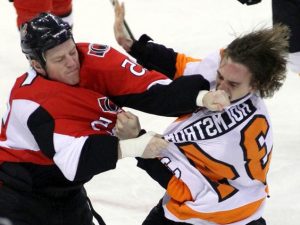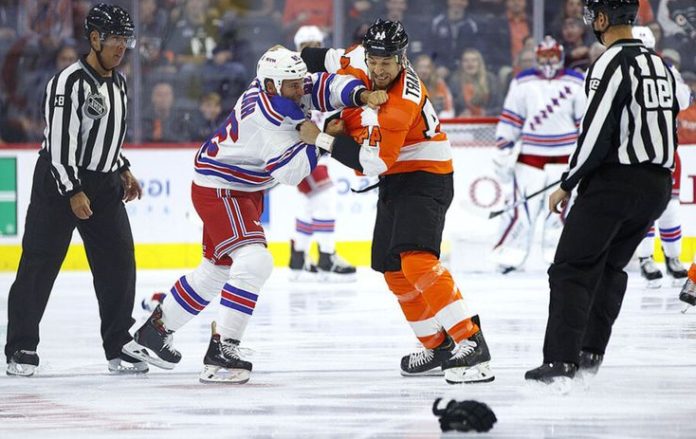Why is Fighting Allowed in Hockey
Hockey fights: some fans love them, others hate them. Here’s the lowdown:
-
For Fighting: Some folks say fighting keeps the game clean. If a player throws a mean elbow, they might get their nose punched to teach them a lesson (think of it as a penalty they can’t avoid). It can also be a way for teammates to stick up for each other.
-
Against Fighting: Others say fighting is just dangerous and unnecessary. Players can get hurt, and there are already penalties for bad hits. Why add more violence?
The fight over fighting goes on, with some leagues even making new rules to try and stop it.
Hockey is like magic on ice, with sticks and a puck! People all over the world love watching it because it’s both skillful and tough. Players score goals and help each other score (that’s an assist!), showing their amazing skills. But sometimes, things get heated and players take off their gloves to fight (fisticuffs means punching)! This adds another layer of excitement (intrigue) to the game for some fans.
Historical Context of Fighting in Hockey
The inclusion of fighting in hockey dates back to its early origins. In the rough-and-tumble outdoor games played in Canada during the 19th century, physical altercations were not uncommon. As the sport evolved and organized leagues emerged, fighting became somewhat of an accepted norm, albeit with varying degrees of regulation.
Also, read about How many periods in hockey
Entertainment and Tradition
One of the primary arguments in favor of allowing fighting in hockey is its entertainment value. For many fans, the adrenaline rush of a heated altercation adds an extra dimension of excitement to the game. Additionally, fighting has become ingrained in hockey culture, with legendary brawls and iconic enforcers celebrated as part of the sport’s folklore.
Enforcing Player Safety
Despite its popularity, fighting in hockey is not without its critics. Opponents argue that it poses unnecessary risks to player safety and sets a poor example for younger athletes. In response, leagues have implemented measures such as penalties and fines to discourage excessive violence while still preserving the physicality that defines the sport.

Psychological Aspects
Beyond its physical impact, fighting in hockey can also have psychological implications. For players, engaging in fisticuffs can serve as a form of catharsis, allowing them to release pent-up frustration or defend teammates. Moreover, the threat of retaliation can deter opponents from taking liberties with skilled players, thus influencing team dynamics on the ice.
Economic Factors
From a business perspective, the presence of fighting in hockey can have significant financial implications. While some argue that it boosts ticket sales and television ratings by appealing to a certain demographic, others worry about its effect on the sport’s image and marketability. Ultimately, leagues must strike a balance between profitability and integrity. Discover more about What is icing in hockey
Comparisons with Other Sports
To better understand the role of fighting in hockey, it’s essential to compare and contrast with other sports’ approaches to physicality and violence. While some sports, such as boxing and mixed martial arts, embrace combat as a central component, others, like soccer and basketball, have stricter rules against aggression. Societal attitudes towards violence in sports vary widely and reflect broader cultural norms.
Ethical Considerations
The debate over fighting in hockey raises important ethical questions about the role of violence in sports. Critics argue that glorifying physical altercations sends the wrong message and normalizes aggression. On the other hand, proponents contend that it’s a natural part of competition and can serve as a release valve for tensions that might otherwise boil over.
Player Perspectives
To gain insight into the mindset of those directly involved, it’s valuable to consider the perspectives of professional hockey players. While opinions may vary, many players view fighting as a strategic tool rather than a gratuitous spectacle. Some argue that it fosters camaraderie and accountability within teams, while others acknowledge its risks and advocate for stricter regulations.

Fan Perspectives
Hockey fans, too, have diverse opinions on the role of fighting in the sport. While some relish the physicality and raw emotion it brings to the game, others prefer a more refined style of play. Surveys and testimonials reveal a spectrum of views, with some fans embracing fighting as an integral part of hockey’s identity and others calling for its elimination.
Evolution of the Game
As hockey continues to evolve, so too may its stance on fighting. In an era of increased emphasis on player safety and sportsmanship, leagues may face growing pressure to reevaluate their policies regarding physical altercations. While the future of fighting in hockey remains uncertain, one thing is clear: it will continue to be a topic of passionate debate among players, fans, and policymakers alike.
Conclusion
In conclusion, the allowance of fighting in hockey is a complex issue with roots in tradition, entertainment, safety, and ethics. While proponents argue that it adds excitement and strategic depth to the sport, opponents raise valid concerns about player safety and the message it sends to impressionable audiences. Ultimately, finding a balance between preserving hockey’s physicality and safeguarding player well-being is essential for the sport’s long-term viability.
FAQs:
Is fighting an official part of hockey’s rules?
While fighting is not explicitly condoned in the rulebook, leagues often tolerate it to a certain extent, with penalties imposed for excessive violence.
Do all hockey players engage in fighting?
No, fighting is typically associated with a specific role known as the “enforcer,” whose primary responsibility is to protect teammates and intimidate opponents.
What measures are in place to prevent injuries during fights?
Leagues have implemented rules such as mandatory helmets and penalties for instigating fights to mitigate the risk of serious injury.
Are there cultural differences in attitudes towards fighting in hockey?
Yes, while fighting is more accepted in North American hockey culture, European leagues tend to have stricter regulations and a lower tolerance for violence.
Could hockey evolve to eliminate fighting altogether?
It’s possible, but it would require significant changes to the sport’s culture and rules, as well as buy-in from players, fans, and league officials.




